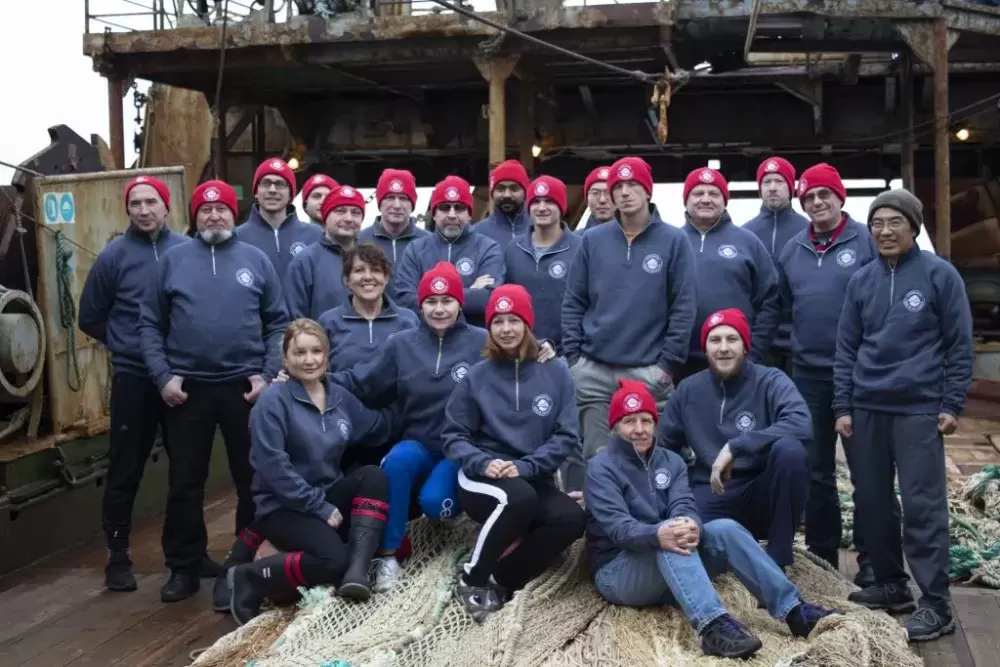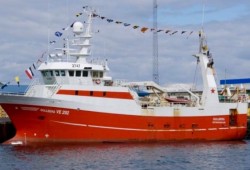An international team of scientists returns to the North Pacific this winter, determined to learn more about ways in which climate change and shifting ocean conditions are contributing to collapsing salmon stocks.
The second Canadian-led Gulf of Alaska expedition will chart the same course as a trawl survey of Pacific salmon launched in 2019 with the goal of building broader international co-operation.
Brian Riddell, a scientific adviser to the non-profit Pacific Salmon Foundation (PSF), said the results of last winter’s research — along with some of the worst salmon returns ever to B.C. rivers in 2019 — make the follow-up survey essential.
“It’s going to be very similar because we’re going to repeat what we did last year,” Riddell explained. “How we fish depends on the weather.”
Last year’s expedition, organized in conjunction with the International Year of the Salmon, provided scientists from B.C., Russia and Japan with a long overdue opportunity to conduct joint research on high-seas salmon migration. By sampling ocean catches for disease, diet, size and genetics, they hope to advance understanding of how mechanisms regulate ocean survival.
As managing partner of the project, PSF is raising funds to augment $1 million provided through the B.C. Salmon Restoration and Innovation Fund, announced last year by the Canadian government. Additional support has come from fishing companies and private donors.
Ocean survival is sometimes referred to as the “black box” of salmon migration. Science has yet to explain the complex interactions that enable salmon to navigate vast distances and return to their streams of origin. What happens to the various species as they winter in the gulf?
Declines, particularly among chinook, sockeye and coho runs, have made the question much more than academic. Changes in climate, marine productivity and ocean conditions — notably the resurgence last year of the North Pacific warm-water anomaly known as “the blob” — have added a greater sense of urgency, a pressing need to close the knowledge gap.
“A lot of what we’re trying to do is to explain how climate and weather drive everything to do with the oceans,” said Mark Saunders, director of the International Year of the Salmon (IYS), a program of the North Pacific Anadromous Fish Commission. “You’ve got a situation like the warm blob, really a growing anomaly of heat waves all over the planet.”
Due to the weather-related phenomenon, dynamics that usually drive ocean conditions instead stall out in high-pressure areas for extended periods, Saunders explained.
“You wind up with some pretty dramatic changes with the way the oceans are functioning,” he said.
In the House of Commons Jan. 25, Courtenay-Alberni MP Gord Johns stressed the severity of the West Coast salmon crisis.
“Last fall, we had the lowest return of the Fraser River sockeye in recorded history,” Johns told fellow MPs. “This is the largest salmon-bearing stream in the world. We had low returns in Clayoquot, in the Skeena, in the Kennedy. Last year in the Kennedy, we did not have a single returning spawning fish. This is a salmon-bearing area that produced 200,000 fish just decades ago. It is clear that there is a salmon emergency taking place in British Columbia. A crisis is taking place in British Columbia.”
The offshore research was spearheaded by Dick Beamish, a retired Pacific Biological Station director who continues to steer the initiative as it expands.
“As we started to build it, it grew into a bigger piece as part of International Year of the Salmon,” Saunders said. “Dick always wanted to get ships back onto the high seas.”
Canada’s high-seas salmon research lapsed for 10 to 15 years, he noted. Illegal driftnet fishing, which clobbered stocks for years, had ceased to be a threat back then. As well, there wasn’t a research vessel available to do the work, Saunders said.
“Before the increased uncertainty due to climate change, they could get a fairly good idea close to home” in terms of stock recruitment and run size, he noted. With returns often falling far short of projections, that’s no longer the case.
Catch rates during last winter’s survey were lower than expected, yet fish were generally in good health. For the first time, researchers were able to estimate total salmon abundance in the survey area: roughly 55 million. Chum were found in greatest abundance among the five species, followed by coho.
“Coho were quite interesting,” Riddell said. “We caught quite a few out in the Gulf of Alaska and two-thirds of them were from north central B.C. Coho have not been thought to be open-ocean fish.”
There they were, though, 1,000 kilometres offshore. Real-time genetic sampling, conducted at sea for the first time, revealed the coho originated in northern B.C. down to Puget Sound in Washington State.
Based on a surprisingly low sockeye catch, they predicted a low return of 600,000 adults, Riddell said. The number that actually returned was close, about 500,000, a fraction of the run forecast by DFO. Whatever causes high mortality in sockeye must be occurring before they reach the Gulf of Alaska, the scientists concluded.
They also expected to find more pink — supposedly the most abundant salmon in the North Pacific — though low numbers were consistent with poor returns in Alaska and southern B.C.
Riddell spent most of his career with DFO and co-authored Canada’s policy for conservation of wild Pacific salmon 15 years ago. He believes multiple factors are causing stock declines. There is no question, though, that a warmer North Pacific is having an effect over multiple years and across broad areas. Various stock enhancement measures could be applied to address declines.
“We have the tools to help,” he added. “I don’t know if we can incorporate them quickly enough.”
The 2020 expedition will have fewer scientists aboard due to space constraints. Instead of the Russian research vessel used last year, they have hired the Canadian commercial trawler Pacific Legacy. Meanwhile, an expanded survey is planned for next year.
“For 2021, the vision — and it actually comes from Russia — was we have to do a full pan-Pacific survey of salmon migration,” Saunders said. Next year’s expedition will involve five vessels and span overlapping migratory paths of salmon from Asia and North America.








